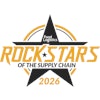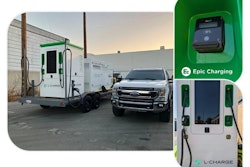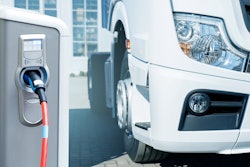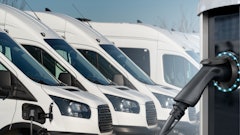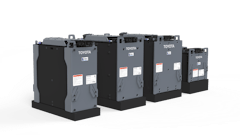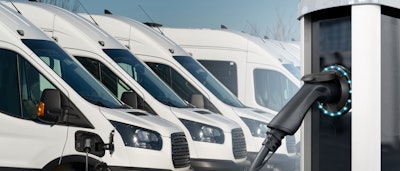
With improvements in battery energy density, fast-charging capabilities and renewable energy sources, fleet electrification in the food logistics chain is gaining attention. And for good reason. Electrified fleets can offer significant environmental and operational benefits, delivering energy efficiency and reduced fuel costs all while benefitting the planet.
But what about the within the cold food chain? Sustainability is definitely influencing the market. The global transport refrigeration unit (TRU) market is projected to grow from $13.55 billion in 2023 to $21.43 billion by 2032, with electric and hybrid units comprising 14% of the market and growing.
When exploring solutions, it is important to recognize the potential synergies between fleet electrification and refrigeration. Both are mission critical functions in food distribution. And, both can benefit from a shared power infrastructure. This approach can provide resiliency, mitigated energy costs and a better ROI.
Here are some key factors to consider when implementing electrified fleets with a shared infrastructure approach.
Grid strain
Electricity demand in the United States has been on the rise in recent years. The U.S. Energy Information Administration forecasts that power consumption in the United States will reach record levels in 2025 and 2026. This surge combined with aging infrastructure and intensifying weather events can strain the grid during peak demand.
Without a reliable power source, EV fleets can experience slower charging times or vehicle downtime. This holds particularly true for TRUs — as they consume more energy due to the continuous operation of cooling systems. This can reduce range and risk temperature deviations that compromise product quality.
There can also be setbacks with the grid connection needed to ensure reliable, efficient, and scalable integration between the EV infrastructure and the power grid. The surging power demands and slow infrastructure upgrades are creating capacity issues for many utility companies. They are simply unable to guarantee sufficient power to new facilities. The result is often long delays and higher rates for new or upgraded connections. In some cases, such delays can stretch into years.
To help mitigate these challenges, an electrical resilience strategy should be an integral part of the initial planning of any electric vehicle (EV) fleet implementation.
Building power resilience
Fortunately, new methods of energy management are now available to increase reliability and resiliency. Electric vehicle (EV) charging stations can be combined with renewables (such as solar) and battery energy storage systems (BESS) to create your own power. These systems generate and store energy to provide backup power for charging stations and TRUs during any disruption.
Cost is paramount when weighing back-up power solutions. While shared systems reduce individual costs, initial investment for chargers, BESS, or microgrids can be high.
According to a study from the Environmental Defense Fund, solar-plus-storage was found to be the most cost-effective solution using a net present value of a 20-year project. While this combination has higher upfront costs, it was the only back-up power solution that was found to provide value greater than the investment required to purchase the solution.
Leveraging intelligent microgrids
Localized power grids (or microgrids) provide a decentralized approach to energy distribution to bolster on-site energy capacity. Microgrids can be a game-changer for fleets, especially TRUs that need reliable power to keep cargo at the optimal temperature.
What makes a microgrid “intelligent” is the set of control systems that can manage, store, charge, and discharge the entire system at any given time. These controls can be programmed to monitor the supply versus demand of power being pulled from the central grid and the real-time cost of power on the market. If the control system detects low energy prices, it can switch to purchasing power from the grid while using battery systems to store self-generated power from solar panels for future use. Subsequently, the controller can discharge these batteries when prices increase, ensuring more stable energy costs.
The system also has the ability to operate autonomously, ensuring an uninterrupted power supply even during grid outages or disruptions. Dashboards can track power usage and TRU performance, enabling rapid response to outages or equipment failures. This level of real-time energy management improves energy performance, control costs and increases predictability.
Shared infrastructure
Shared power infrastructure for fleet electrification and refrigeration integrates a blend of physical assets, software solutions, and collaborative frameworks. This could include charging stations, energy storage, backup power systems and energy management systems.
For example, EV charging stations can be co-located with refrigeration facilities, leveraging the same renewable energy sources to power both. Centralized stations with high-capacity chargers can be used for both EVs and electrified TRUs. Or, EVs can feed stored energy back to shared systems, stabilizing power for refrigeration during disruptions.
Foundational success
Preparing any facility for electrification is a massive undertaking. Upfront investment in electric equipment and retrofitting facilities can be high, although long-term savings and incentives often pay off over time. Therefore, careful and detailed planning is critical to ensure the installation is safe, reliable, and future proof.
Fleets must first identify how much power and stored energy they need. This should include an assessment of what loads are critical. High-power charging for multiple fleets may strain local grids, necessitating utility upgrades or storage solutions. Armed with information on power energy and needs, fleet managers can start planning their backup systems accordingly.
Ensuring compatibility between diverse EV models, TRUs, and charging systems can be complex. Plus, permitting, and zoning can delay projects. Once deployed, it important to conduct regularly scheduled, preventative maintenance to maximize uptime and ROI with minimal operating expenditures.
The implementation of a shared power infrastructure can also be complex. There are technical factors like system design and compatibility. There are economic factors like cost sharing and revenue mechanisms. There are regulatory factors like compliance and ownership models. And there are many operational factors. This is just a fraction of the considerations necessary to ensure feasibility, efficiency, and scalability. An experienced EV infrastructure and energy consultant can provide the expertise and guidance to help navigate these challenges.
As the cold food chain begins the journey toward electrification, efficient and resilient fleet operations are essential. Shared infrastructures — combining assets like charging hubs, microgrids and energy management solutions — may hold the key to charging forward with success.



